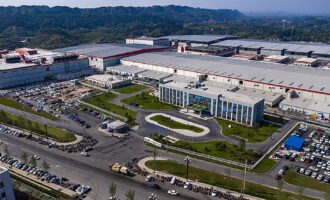
The future of e-mobility in Thailand
When you consider the leading automobile manufacturing countries, Thailand may not be one that immediately springs to mind. Nevertheless, Thailand is consistently ranked number one in terms of total automobile production in Southeast Asia, with an annual output of around two million vehicles, and is positioned 11th in the world. The majority of vehicles are developed and licensed by foreign producers from Japan, the United States and China; with major brands such as Toyota, Honda, Mitsubishi, Nissan and Ford all having affiliations with Thailand.
Thailand has developed a strong reputation for producing internal combustion engine (ICE) vehicles. However, the Southeast Asian nation is looking to pivot its manufacturing might to more environmentally friendly construction.
Speaking at the Asian Lubricants Industry Association (ALIA) Annual Meeting in Bangkok on April 26, 2022, Associate Professor Dr. Werachet Khan-ngern, research and innovation director at Kumwell Corporation, cited hydrogen fuel cell electric vehicles (FCEV) as “the future” of mobility in Thailand. Werachet, a member of Thailand’s National Electric Vehicle Policy Committee, acknowledged the immediate role of biofuels in improving emissions and displacing petroleum, as well as a strong focus on encouraging the uptake of battery electric vehicles (BEV).
Werachet has been chairman of VERA Automotive Co., Ltd., Thailand’s first electric car brand, since 2016, and has extensive experience in the electrification of mobility, including as an advisor to the INNOGEN KMITL Team (Electric vehicle Shell Eco Marathon Challenge) from 2007 to 2020. He also has more than 10 years of experience in hydrogen fuel cells.

Currently, BEVs are thin on the ground in Thailand. In 2021, new registrations for BEVs were approximately 1,900 units, according to the Electric Vehicle Association of Thailand. This compares to 38,600 newly registered hybrid electric vehicles (HEV)s and plug-in hybrid electric vehicles (PHEVs), with a cumulative volume of 219,044.
The Thai government understands the importance of maintaining its strength as the auto manufacturing hub in Southeast Asia and is looking to seize on the opportunity for growth in electric vehicles (EV). The government previously announced a goal of converting 30% of Thailand’s total auto production to EVs by 2030.
In his presentation, Werachet outlined recent incentives implemented by Thailand’s cabinet to encourage the production and domestic use of EVs. Enticements include tax breaks and subsidies for imported models and those made locally.
The incentives, announced in February 2022, include a 40% reduction in customs duty for completely built-up (CBU) battery EVs priced up to THB2 million (USD61,805), or 20% for those priced between THB2 million (USD 61,805) and THB7 million (USD 211,278) from 2022 to 2023. Excise tax has also been cut from 8% to 2% for imported EVs, a move that is expected to add 7,000 EVs in the first year, says Werachet.
Incentives outlined in the 2022-2025 package cover 27 models of EVs including eco-cars with 10 seats or less; 1-ton electric pickups; hydrogen fuel cell-powered trucks; EVs with 10 seats or less; and plug-in four-door passenger pickups.
Werachet detailed further subsidies including a THB70,000 (USD2,111) subsidy for passenger cars with 10 to 30 kWh battery capacity for completely knocked-down (CKD) and CBU units, and a THB150,000 (USD4,523) subsidy for passenger cars with over 30kWh battery capacity. Completely knock-down refers to a product that is delivered in parts and assembled at the destination. Electric motorcycles from eligible car producers between 2022-2023 will also attract an THB18,000 subsidy.
Exemptions on critical electrical components such as batteries, traction motors, compressors for battery EVs, battery management systems, drive control units, and reduction gear are also available between 2022-2025, says Werachet. The Kumwell Corporation representative indicated that a 16- 23% price reduction could be expected on EVs with a 50-kWh battery after tax breaks and subsidies are applied. The Thai government has also been entering into direct agreements with EV companies on incentives, tax breaks and subsidies. Toyota was the latest automaker to sign a memorandum of understanding (MoU) with the Thai government on incentives in April 2022.
Funding for the EV incentive program will come from the Thai government’s longer-term THB40 billion (USD1.2 billion) investment in the EV industry and a further allocation of THB3 billion (USD90.4 million) from the 2022 central budget.
New incentives are likely to drive growth in zero-emission vehicles, as has been the case in other jurisdictions throughout the globe. However, Thailand will face challenges as it looks to transition from ICE to EVs, says Werachet. Thailand may take up to a decade to produce EVs effectively since existing supply chains are manufacturing parts and bodies for vehicles with ICEs, he says.

Werachet also highlighted some of the key challenges facing Thailand’s auto manufacturers if they are to achieve the required EV growth, ranging from insufficient infrastructure to financial barriers.
Of particular concern are EV driving range and a lack of charging infrastructure. While an ICE fuel tank can be filled within five minutes at one of approximately 30,000 gas stations in the country, there are only an estimated 1,000 public EV charging points. Werachet outlined plans to ensure that one charging station is available every 150 km.
In a country where home charging is not a given, this still feels like a serious lack of infrastructure and could limit EV adoption. Though, several private sector companies have recently announced greater investment in charging infrastructure. In February 2022, PTT Oil and Retail revealed it would triple the number of EV charging stations in its existing gas stations and Eppo unveiled plans for 567 EV charging stations with 13,251 fast chargers across the nation by 2030.
Financial barriers remain for consumers in Thailand. Despite EVs comprising substantially fewer moving parts than their ICE counterparts, they remain more expensive due to the lack of economies of scale. Though, the gap is closing. Werachet emphasised considerable upside for EVs in terms of operating costs, maintenance costs and, of course, environmental impact.
Thailand continues to rely heavily on fossil fuels for its energy supply. One-third of the total primary energy supply in 2019 was natural gas. However, investments in renewable energy have led to dramatic improvements in the environmental impact of the Southeast Asian nation. One-third of energy capacity now comes from renewable sources, which is set to increase alongside greater demand for electricity in the coming years.
Werachet outlined several energy efficiency opportunities around various forms of vehicle-to-X technology, including use cases such as vehicle-to-home (V2H), vehicle-to-load (V2L), and vehicle-to-grid (VSG) technology. These approaches enable interaction between the electricity network and EVs, forming a key part of a smart electricity network. The arrangement can balance variations in energy production and consumption by enabling energy to be pushed back to the power grid from the battery of an electric car.








